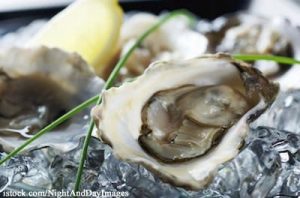Oysters are on a lot of holiday menus. But if your’re thinking of serving them raw, be aware that oysters contaminated with Vibrio vulnificus can cause life-threatening illness or fatality for people with certain medical conditions, according to the U.S. Food and Drug Administration (FDA). Those who should never consume raw oysters include pregnant women and people with cancer, diabetes, stomach disorders, compromised immune systems, liver disease from hepatitis, cirrhosis, alcoholism and iron overload disease. Those who consume two to three drinks daily should also avoid consumption of raw oysters.
 What’s the danger?
What’s the danger?
Vibrio vulnificus infections for high-risk individuals have a 50 percent fatality rate, often within 48 hours. Symptoms of an infection usually develop within 24 to 48 hours of ingestion and include fever, chills, nausea, vomiting, diarrhea, shock and skin lesions. Anyone in the high risk group who develops these symptoms after eating raw oysters or other raw shellfish should see a doctor immediately.
Vibrio vulnificus are naturally occurring bacteria in saltwater and are not the result of pollution. (Those in the high-risk group can also contract Vibrio infections if they have cuts, burns or sores that come in contact with seawater containing the bacteria). Because oysters are filter feeders, Vibrio can get trapped in their issues.
An oyster contaminated with Vibrio won’t taste off or look unusual. Because Vibrio is not caused by pollution, eating oysters from certain areas perceived as “clean” wil not reduce the risk, nor will eating them at a reputable restaurant with a high turnover rate. Hot sauce as a garnish does not kill the bacteria and neither does alcohol. The only thing that destroys Vibrio is heat. Pasteurized oysters or dishes that include fully cooked oysters are the safest options for a holiday crowd.




